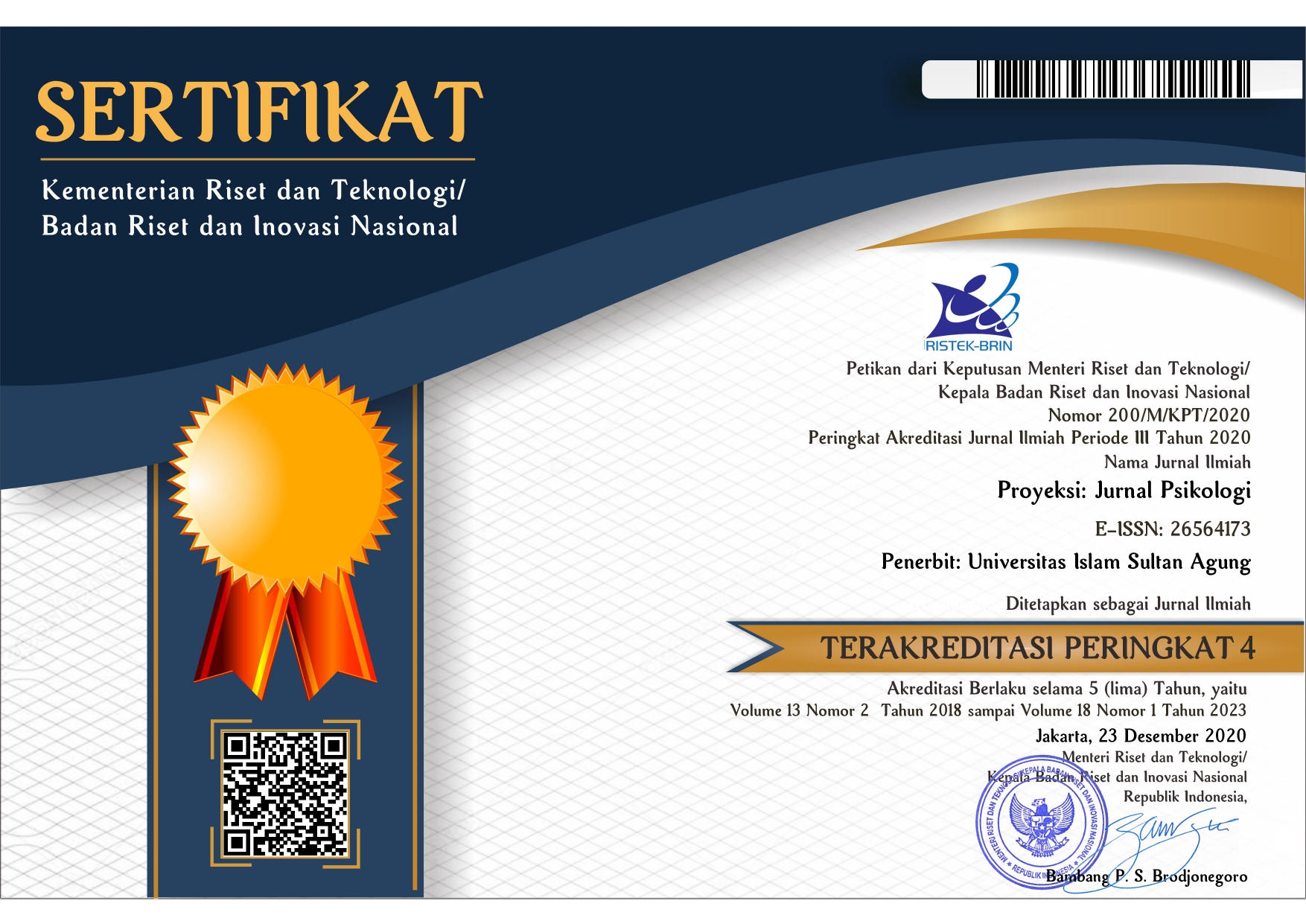UJI VALIDITAS KONSTRUK ALAT UKUR KEPRIBADIAN HEXACO-60 BERBAHASA INDONESIA DENGAN CONFIRMATORY FACTOR ANALYSIS (CFA)
Abstract
Sebagai salah satu instrumen psikologis yang berhasil memodelkan kepribadian manusia hingga saat ini, HEXACO perlu dievaluasi keabsahannya dengan prosedur pengujian yang telah berlaku. Dengan menggunakan HEXACO berbahasa Indonesia yang memuat 60 aitem, penelitian ini menguji properti psikometris alat ukur ini dengan melibatkan sampel penelitian mahasiswa dan pekerja (N=940) yang berdomisili di beberapa kota besar di Indonesia. Metode penelitian yang digunakan adalah Confirmatory Factor Analysis untuk menguji validitas dan metode Crobanch's alpha sebagai uji reliabilitas. Penelitian ini menunjukkan bahwa secara umum HEXACO-60 memiliki validitas dan reliabilitas baik walaupun dua aspeknya memiliki reliabilitas yang relatif sedang, yaitu Honesty-Humility dan Agreeableness dengan skor Crobanch's alpha adalah 0,48 dan 0,58.Â
Keywords
Full Text:
PDFReferences
Ashton, M. C., & Lee, K. (2007). Empirical, theoretical, and practical advantages of the HEXACO model of personality structure. Personality and Social Psychology Review, 11(2), 150–166. https://doi.org/10.1177/1088868306294907
Ashton, M. C., Lee, K., & Visser, B. A. (2019). Where’s the H? Relations between BFI-2 and HEXACO-60 scales. Personality and Individual Differences. https://doi.org/10.1016/j.paid.2018.08.013
Ashton, M. C., Perugini, M., De Vries, R. E., Boies, K., Lee, K., Szarota, P., Di Blas, L., & De Raad, B. (2004). A Six-Factor Structure of Personality-Descriptive Adjectives: Solutions from Psycholexical Studies in Seven Languages. Journal of Personality and Social Psychology. https://doi.org/10.1037/0022-3514.86.2.356
Atkinson, T. M., Rosenfeld, B. D., Sit, L., Mendoza, T. R., Fruscione, M., Lavene, D., Shaw, M., Li, Y., Hay, J., Cleeland, C. S., Scher, H. I., & Breitbart, W. S. (2012). NIH Public Access. 41(3), 558–565. https://doi.org/10.1016/j.jpainsymman.2010.05.008.Using
Beaton, D. E., Bombardier, C., Guillemin, F., & Ferraz, M. B. (2000). Guidelines for the process of cross-cultural adaptation of self-report measures. In Spine. https://doi.org/10.1097/00007632-200012150-00014
Boies, K., Lee, K., Ashton, M. C., Pascal, S., & Nicol, A. A. M. (2001). The structure of the French personality lexicon. European Journal of Personality. https://doi.org/10.1002/per.411
Cabaços, Carolina & Pereira, Ana & L, Igreja & AP, Amaral & Marques, Cristiana & Araújo, Ana & Macedo, A. (2020). Psychometric properties of the HEXACO-60 in a sample of Portuguese adults from the general population. European Psychiatry, 63, S45–S282.
Chin, W. W. (1998). The Partial LEast Squares Approach to Structural Equation Modelling. In Modern Methods for Business Research (pp. 295–336).
Empati, J., Primawestri, K. R., & Prasetyo, A. R. (2016). Kepribadian Honesty-Humility Dan Perilaku Impression Management Pada Karyawan Dinas Koperasi Dan Umkm Provinsi Jawa Tengah. Empati, 5(4), 780–785.
Fiske, D. W. (1949). Consistency of the factorial structures of personality ratings from different sources. Journal of Abnormal and Social Psychology. https://doi.org/10.1037/h0057198
GarcÃa, L. F., Aluja, A., Rossier, J., Ostendorf, F., Glicksohn, J., Oumar, B., Bellaj, T., Ruch, W., Wang, W., Kövi, Z., ÅšcigaÅ‚a, D., ÄŒekrlija, Ä., Stivers, A. W., Di Blas, L., Valdivia, M., Ben Jemaa, S., Atitsogbe, K. A., & Hansenne, M. (2021). Exploring the stability of HEXACO-60 structure and the association of gender, age, and social position with personality traits across 18 countries. Journal of Personality. https://doi.org/10.1111/jopy.12664
Ghozali, I., & Fuad, F. (2008). Structural Equation Modeling. Universitas Diponegoro.
Goldberg, L. R. (1992). The Development of Markers for the Big-Five Factor Structure. Psychological Assessment. https://doi.org/10.1037/1040-3590.4.1.26
Hair, Joseph F., J., Hult, G. T. M., Ringle, C., & Sarstedt, M. (2014). A Primer on Partial Least Squares Structural Equation Modelling {PLS-SEM}. SAGE Publication, Inc.
Hu, Z., & Li, J. (2015). The integration of EFA and CFA: One method of evaluating the construct validity. Global Journal of Human Social-Science: A Arts & Humanities -Psychology.
Lee, K, & Ashton, M. (2004). Multivariate Behavioral Psychometric Properties of the HEXACO Personality Inventory Psychometric Properties of the HEXACO Personality Inventory. Multivariate Behavioral Research, 39(January), 329–358. https://doi.org/10.1207/s15327906mbr3902
Lee, Kibeom, Ashton, M. C., & De Vries, R. E. (2005). Predicting workplace delinquency and integrity with the HEXACO and Five-factor models of personality structure. In Human Performance. https://doi.org/10.1207/s15327043hup1802_4
McCrae, R. R., & Costa, P. T. (1987). Validation of the Five-Factor Model of Personality Across Instruments and Observers. Journal of Personality and Social Psychology. https://doi.org/10.1037/0022-3514.52.1.81
Moshagen, M., Thielmann, I., Hilbig, B. E., & Zettler, I. (2019). Meta-Analytic Investigations of the HEXACO Personality Inventory(-Revised). Zeitschrift Für Psychologie. https://doi.org/10.1027/2151-2604/a000377
Ørnfjord, M. (2018). The Norwegian Hexaco-Pi-R: Psychometric properties and relationships with the Big Five Inventory. Scandinavian Psychologist, 5(January), 0–25. https://doi.org/10.15714/scandpsychol.5.e15
Sahadi, S., & Wibowo, M. A. (2013). Pengaruh Faktor Motivasi dan Kepercayaan Terhadap Kinerja Melalui Komitmen Pada Manajer Proyek Kontruksi Dengan Pendekatan Structural Equation Modeling. Jurnal Ilmu Dan Terapan Bidang Teknik Sipil, 19(2).
Skimina, E., Strus, W., Cieciuch, J., Szarota, P., & Izdebski, P. K. (2020). Psychometric properties of the Polish versions of the HEXACO-60 and the HEXACO-100 personality inventories. Current Issues in Personality Psychology. https://doi.org/10.5114/cipp.2020.98693
Skimina, E., Szarota, P., & Cieciuch, J. (2020). of the HEXACO-60 and the HEXACO-100 personality inventories. Current Issues in Personality Psychology.
Sousa, P., Marques, C., Pereira, A., Lino, F., Amaral, A., Mota, D., Ferreira, S., Coroa, M., & Macedo, A. (2018). Confirmatory factor analysis of the Hexaco-60 in a sample of Portuguese university students. European Psychiatry.
Suhr, D. (2006). Exploratory or Confirmatory Factor Analysis ? Statistics and Data Analysis, 31, 1–17.
Taherdoost, H. (2018). Validity and Reliability of the Research Instrument; How to Test the Validation of a Questionnaire/Survey in a Research. SSRN Electronic Journal, January 2016. https://doi.org/10.2139/ssrn.3205040
Tarigan, M., & Fadillah, F. (2021). Uji validitas eksternal tes kepribadian HEXACO-60. 13(1).
Tavakol, M., & Dennick, R. (2011). Making sense of Cronbach’s alpha. In International journal of medical education. https://doi.org/10.5116/ijme.4dfb.8dfd
Umar, J., & Nisa, Y. F. (2020). Uji validitas konstruk dengan CFA dan pelaporannya. Jurnal Pengukuran Psikologi Dan Pendidikan Indonesia, 9(2), 1–11.
Wijanto, S. (2008). Struktural Equation Modelling dengan Lisrel 8.8. Graha Ilmu.
DOI: http://dx.doi.org/10.30659/jp.17.1.14-28
Refbacks
- There are currently no refbacks.

Proyeksi by http://jurnal.unissula.ac.id/index.php/proyeksi/ is licensed under a Creative Commons Attribution-ShareAlike 4.0 International License.

